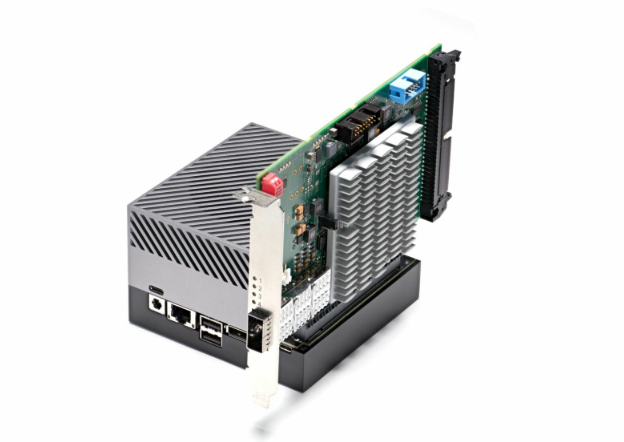As urban congestion continues to grow, the need for smarter traffic management is more urgent than ever. Enter SINTRONES’ cutting-edge NVIDIA Jetson AGX Orin, a powerful Edge AI Solution for traffic management. With its advanced capabilities, it offers real-time data processing and decision-making, turning busy intersections into smoother, more efficient networks. But is this the game-changer cities need? Let’s explore the features, potential applications, and how this innovative technology is set to revolutionize traffic management worldwide. Buckle up for an exciting journey!
What Is Edge AI?
Edge AI is the combination of edge computing and artificial intelligence. It allows devices, like cameras or sensors, to process and analyze data locally (on-site) instead of sending it to the cloud. This enables real-time decisions to be made directly where the data is generated, reducing delays and the need for cloud processing.
How Edge AI Works in Local Data Processing
Edge AI makes data processing faster and more efficient by:
- Real-Time Analysis: Edge AI enables instant decision-making, which is important for applications like self-driving cars or automated factories, where quick actions are needed to ensure safety and efficiency.
- Reducing Delays: Processing data locally reduces the time it takes to send it to the cloud, allowing actions like changing traffic lights or rerouting vehicles to happen faster.
- Better Privacy & Security: Storing data locally means less chance of data breaches during transmission and helps comply with privacy laws.
- Saving Bandwidth: Only the most important data is sent to the cloud, which saves bandwidth and reduces costs.
Key Features of SINTRONES’ Edge AI Solution
Powerful AI Performance: The system uses the NVIDIA Jetson AGX Orin module, which can process up to 275 TOPS. This allows it to run advanced AI models and analyze data instantly, without needing cloud processing.
- Durable Design: The system is built with an IP66-rated enclosure, making it weatherproof and ideal for outdoor environments.
- Easy Connectivity: Supports Power over Ethernet (PoE) for easy setup and has GMSL-2 camera interfaces for clear, high-quality video input.
- Car-Friendly Connectivity: The system comes with automotive-grade features like CAN FD and Automotive Ethernet (T1), making it ideal for smart traffic systems.
How It Improves Traffic Flow
SINTRONES’ Edge AI system helps manage traffic by:
- Real-Time Traffic Analysis: It collects and analyzes data from cameras and sensors to understand traffic conditions, such as vehicle density and pedestrian presence.
- Adaptive Traffic Control: The system can adjust traffic lights based on real-time information. For example, if traffic builds up at an intersection, the system can extend the green light to reduce wait times and improve the traffic flow.
SINTRONES’ system helps manage traffic better by analyzing data on the spot, making quick decisions, and adapting to real-time changes to keep traffic moving smoothly.
Real-Time Traffic Analysis and Adaptive Signal Control
SINTRONES’ Edge AI system helps optimize traffic flow by analyzing real-time data from cameras and sensors. It can detect traffic density, types of vehicles, and the presence of pedestrians. Based on this information, the system can adjust traffic lights to improve traffic flow.
For example, if an intersection suddenly experiences more cars, the system can extend the green light or change the traffic signal to accommodate the increased flow, helping reduce wait times and improve overall traffic movement.
Benefits of Real-Time Decision-Making in Traffic Management
- Better Traffic Flow:
- How it works: Real-time decision-making allows traffic signals to adjust dynamically based on current road conditions, such as the number of vehicles or pedestrian activity.
- Impact: This leads to smoother transitions between traffic lights and reduces congestion, allowing vehicles to move more freely and minimizing waiting times at intersections.
- Improved Safety:
- How it works: By analyzing data on the road in real-time, the system can detect accidents, unusual traffic patterns, or even stalled vehicles.
- Impact: It responds quickly by adjusting signal timings or alerting authorities, which helps reduce the chances of further accidents or traffic jams, creating a safer driving environment.
- Operational Efficiency:
- How it works: With automated, real-time adjustments, the system eliminates the need for manual intervention or oversight by traffic officers, saving time and reducing human error.
- Impact: This not only makes traffic management more efficient but also frees up resources that can be used for other tasks, improving overall operations.
- Scalability:
- How it works: Edge AI systems are designed to be modular and flexible, meaning new traffic management components can be added as needed.
- Impact: As cities expand and traffic volumes increase, the system can be easily scaled to meet these demands, ensuring long-term effectiveness and adaptability.
Real-time decision-making in traffic management optimizes traffic flow, enhances safety, boosts operational efficiency, and ensures the system can grow with urban needs, making it an invaluable tool for modern cities.
How Edge AI is Changing Traffic Management
Edge AI is transforming traffic management by processing data locally at the source (e.g., cameras, sensors, vehicles), instead of relying on cloud systems. This results in faster decision-making, leading to smarter traffic systems. Here’s how:
- Faster Decision-Making: With local data processing, decisions like adjusting traffic lights or directing emergency vehicles happen almost instantly.
- Adaptive Traffic Signals: Traffic lights can change in real-time based on traffic conditions, reducing congestion and improving flow.
- Real-Time Detection: Edge AI detects violations, like speeding or red-light running, and accidents as they happen. The system can adjust signals or alert authorities for quicker responses.
- Predictive Traffic Flow: Analyzing past and real-time data helps Edge AI predict traffic patterns and proactively adjust signals to prevent congestion.
Edge AI improves traffic management by creating faster, smarter, and more responsive systems for safer and more efficient urban transportation.
Conclusion: Edge AI Solution for Traffic Management
SINTRONES’ NVIDIA Jetson AGX Orin Edge AI solution provides a powerful platform to address this challenge. By enabling real-time data processing and decision-making, this solution enhances traffic flow, safety, and efficiency, transforming busy intersections into well-managed networks.
Its ability to process data locally reduces delays, improves safety, and ensures more effective traffic management systems for growing cities.
Edge AI benefits traffic management by providing real-time analysis, reducing delays, enhancing safety, and enabling scalable, cost-effective solutions.
Key features of SINTRONES’ platform include advanced AI processing capabilities, real-time traffic analysis, and adaptive signal control. These features allow for smarter traffic lights, real-time detection of accidents and violations, and predictive traffic flow, which help reduce congestion and improve overall traffic efficiency.
SINTRONES’ Edge AI solution, powered by NVIDIA Jetson AGX Orin, provides an innovative way to manage traffic. It helps cities tackle modern transportation challenges by making traffic systems smarter, safer, and more responsive, leading to more efficient and sustainable traffic management globally.


